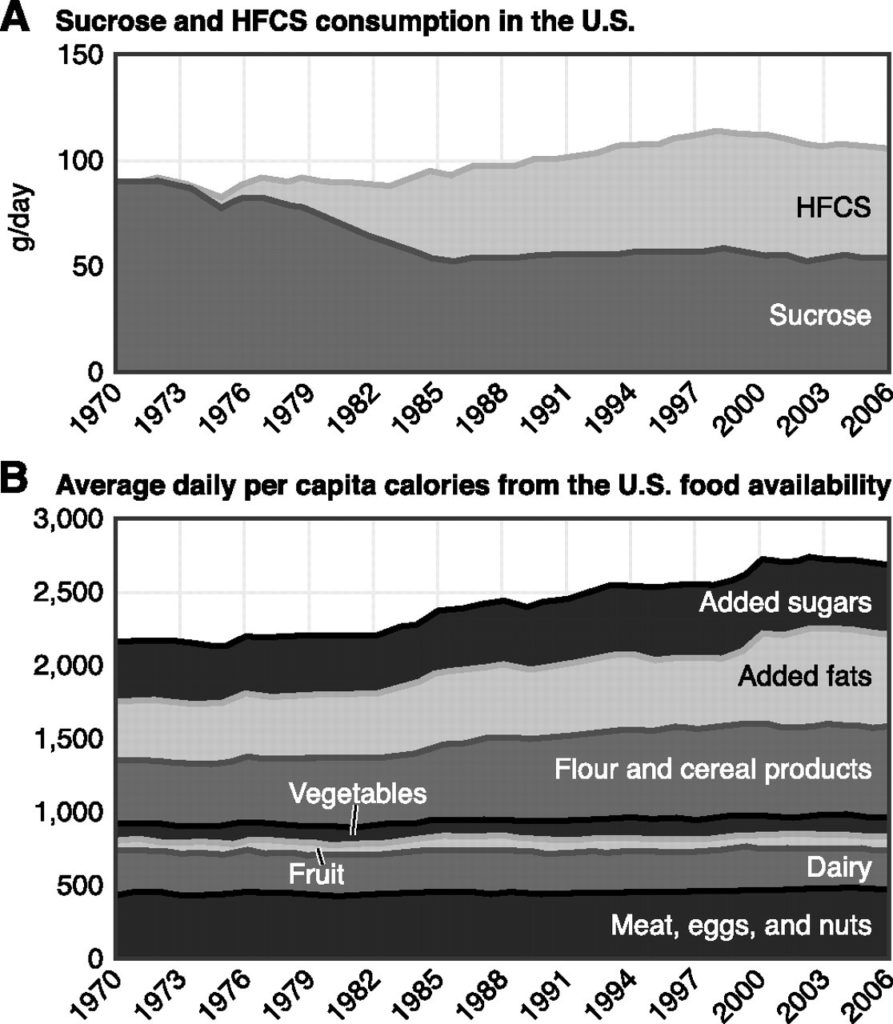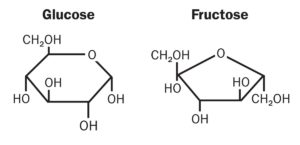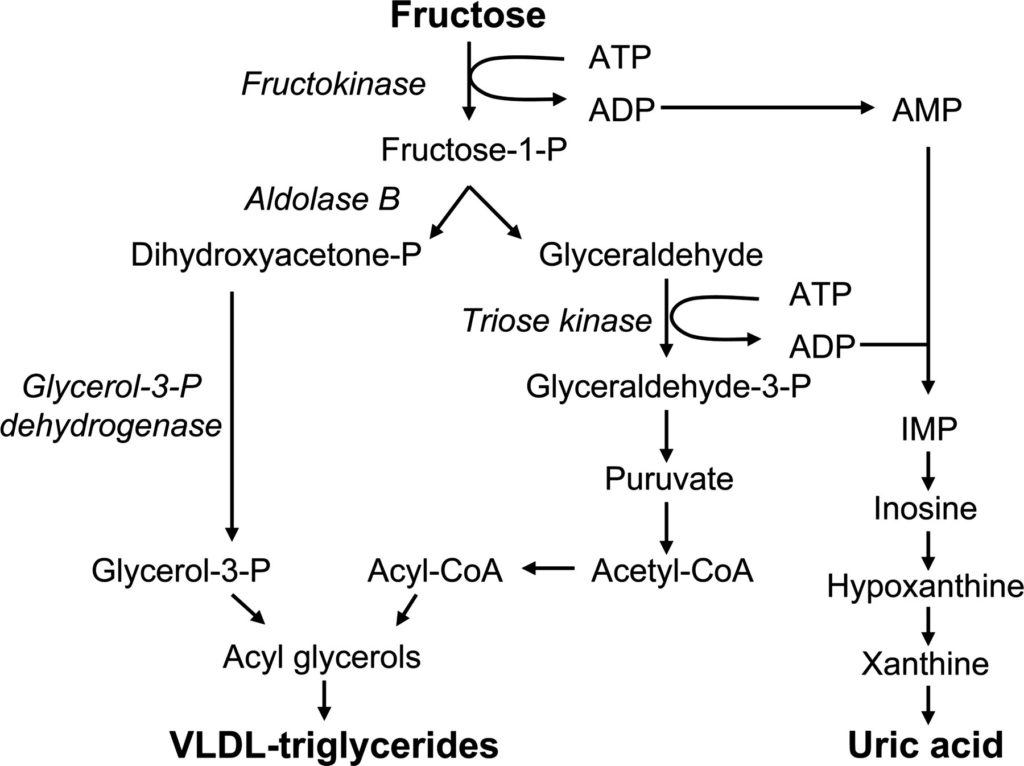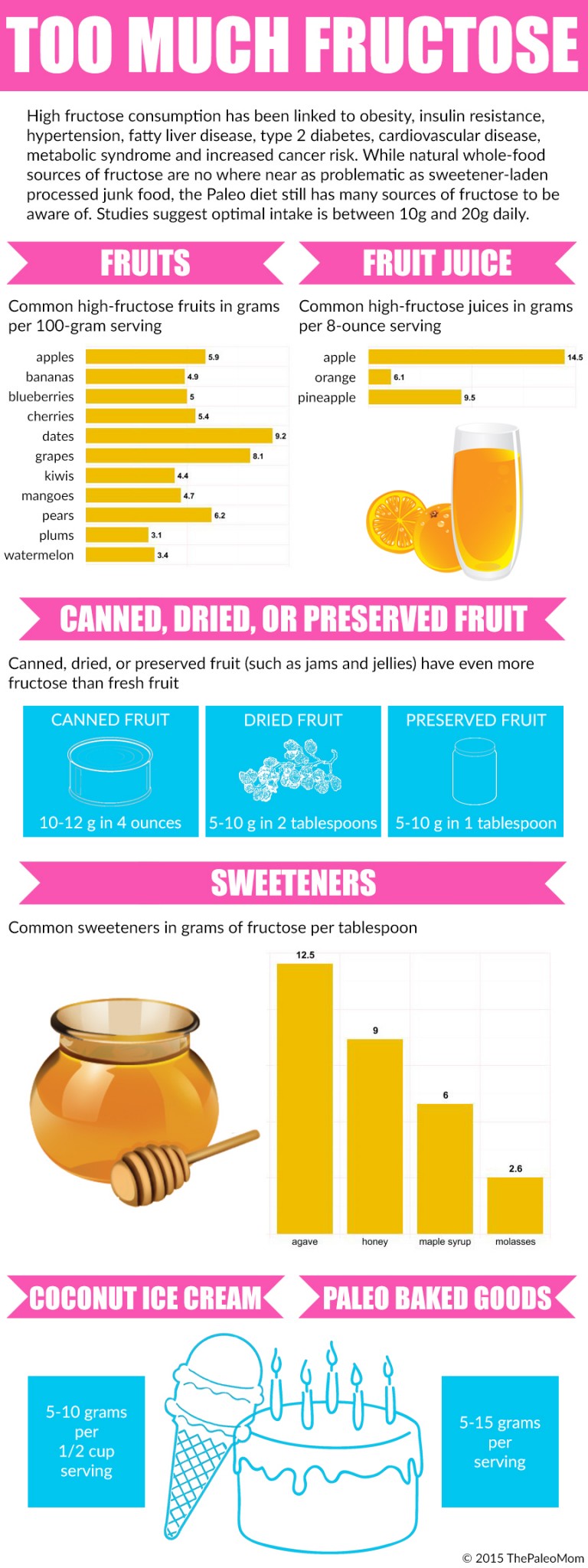A collection of recent research articles focus on the effects of a simple sugar that could be causing a lot of trouble: fructose. Certainly, scientific studies support that low-to-moderate fructose intake is healthful—it’s only high intake of fructose (like the typical intake of the Standard American Diet) that causes problems. While, most of us following a Paleo diet automatically fall into this unproblematic range of fructose consumption, it’s important to address the dangers of high fructose consumption formally (because this new science makes fructose look really bad and because it’s completely possible to overdo fructose within a Paleo framework).
The natural food movement has propelled public awareness of concerns about high fructose corn syrup (HFCS), yet there’s been push-back from the food industry in the form of pro-HFCS commercials on TV (you know it’s “a thing” when SNL does a spoof!). It is definitely all-the-rage to be avoiding products with HFCS, but I think that it’s important to ground our discussion on the pros and cons of any food or lifestyle choice in science.
High fructose consumption has been linked to obesity, insulin resistance, hypertension, fatty liver disease, type 2 diabetes, cardiovascular disease, metabolic syndrome and increased cancer risk. And while the topic of fructose is still considered controversial within the scientific community, it won’t be for much longer, thanks to the recent collection of scientific studies finally elucidating the exact mechanisms of the negative health impacts of high fructose consumption. Yes, correlation does not equal causation, at least until we have the mechanistic studies to explain how A causes B. And with fructose, we do.
Where’s All This Fructose Coming From?
Recent studies have shown that the average amount of fructose consumed daily is around 55 grams and accounts for over 10% of the caloric intake of the American diet (this varies by gender and age group of course, for example young men consume an average of 75g of fructose per day!). Compare this to estimates of historic fructose consumption of between 15g and 20g daily, largely from fruit but also vegetables—on average, we’re our fructose intake is about three times higher. And of course, our fructose consumption has skyrocketed in the last 40 years.

 Fructose is a simple sugar or monosaccharide (meaning that it’s a single carbohydrate molecule, with glucose being another great example of a monosaccharide). Fructose consumption wasn’t really a problem until HFCS was invented. It is used so commonly due to its enriched sweetness (meaning companies have to use less) and its cheap manufacturing price. There have been conspicuous parallels between the rise in overweight/obesity and fructose consumption. HFCS ranges from 42 to 60% fructose (the rest is mostly glucose), which is an incredibly high concentration relative to the amount found naturally in fruit.
Fructose is a simple sugar or monosaccharide (meaning that it’s a single carbohydrate molecule, with glucose being another great example of a monosaccharide). Fructose consumption wasn’t really a problem until HFCS was invented. It is used so commonly due to its enriched sweetness (meaning companies have to use less) and its cheap manufacturing price. There have been conspicuous parallels between the rise in overweight/obesity and fructose consumption. HFCS ranges from 42 to 60% fructose (the rest is mostly glucose), which is an incredibly high concentration relative to the amount found naturally in fruit.
Some argue that HFCS should not be metabolized differently from sucrose (common table sugar, which is composed of a glucose and fructose molecule chemically bonded together), given that HFCS contains fructose and glucose in similar proportions. However, HFCS does not contain those chemical bonds, so the body metabolizes the glucose and fructose independently. Herein lies the difference and therefore the major concern with HFCS, because HFCS is the reason that many people are consuming too much fructose.
Given the amount of fructose the U.S. population consumes and the fact that we’re not dropping like flies after drinking a coke, one would assume that fructose is totally safe to ingest in these amounts, right? Not exactly. There’s a difference between something that is safe in the sense that it won’t kill us quickly and something that actually supports health. The fact is, the research supporting the idea that too much fructose causes metabolic derangement and contributes to heart disease is staggering—and it can all be reduced to the way that fructose is metabolized by our bodies.
Of course, fructose isn’t found that commonly in nature outside of fruit and honey, so most of us following the Paleo lifestyle just aren’t getting as mush as someone eating a Standard American Diet. However, just because we’re Paleo, doesn’t automatically mean that we don’t need to worry about fructose consumption. Excess fruit consumption (fresh or dried) or the use of honey, agave (which can have even higher fructose content than HFCS) or many other “natural” low-glycemic-index sweeteners in “Paleo treats” can mean that many us are getting just as much fructose in our diets as our SAD counterparts (albeit from whole foods rather than processed foods).
So, I want to talk in general about how fructose is metabolized and then discuss two recent scientific papers that give us even more specifics about why we should avoid over-consuming fructose.
Fructose Metabolism
You can see that there is just a small difference (just a couple atoms!) between fructose and glucose. But, glucose can be metabolized in virtually any cell in the body to create energy for our cells, with extra glucose being stored as fat. Glucose is like fructose’s overachieving sibling: it’s able to do more with greater efficiency. When we consume glucose, it makes its way to the bloodstream through our intestinal walls and can be transported into cells using the receptor GLUT4, which is activated by insulin. When someone consumes glucose, the hormone leptin is released from fat cells, telling the brain that the stomach is satiated and that the body has enough energy to do its thing until the next meal. (Insulin and leptin resistance is a different situation, and was discussed here.)
Fructose, on the other hand, is more problematic both from an absorption level (how effectively it is transported from the gut into the bloodstream) and a metabolic level (how it is used for energy and communicates with hormones). Firstly, when fructose is consumed alone, it is relatively difficult for the gut to absorb in comparison to when it is consumed in combination with glucose and protein. Once fructose hits the bloodstream, it does not stimulate insulin release like glucose does. This lack of signaling is an issue, because a large intake of fructose would not generate the appropriate response to sugar intake: releasing the hormone insulin, which is absolutely key for energy balance. This fact alone gives us a clearer understanding of how fructose could be contributing to the obesity epidemic.
Fructose cannot enter most cells to be metabolized, as it requires transport via the GLUT5 protein (whereas GLUT4 transports glucose and is found on almost every cell in the body, but especially where energy is stored or used most: fat cells and muscle cells). (I talk about this in a little more detail in The Paleo Approach on pages 123-124 and in this post.) So, while glucose is like an easy-to-use energy source, fructose must find its way to where it is metabolized before it can be used for energy.
Nutrivore Weekly Serving Matrix
An easy-to-use and flexible weekly checklist
to help you maximize nutrient-density.
The Weekly Serving Matrix is very helpful! I’ve been eating along these lines but this really helps me know where to focus vs. which foods serve a more secondary role. It’s super helpful and has taken a lot of worry out of my meal planning. Thanks!
Jan
Now here’s where it starts to get really problematic: fructose is metabolized almost exclusively in the liver by the enzyme ketohexokinase C (KHK-C). This process puts an additional load on our generally overstressed livers. And, this enzymatic action is key for two reasons: overindulgence in high fructose foods has recently been shown to up-regulate GLUT5 transporters in the gut, and KHK is found only in the heart and the liver. The latter is really important, because it translates to fructose being metabolized in the heart to create more heart cells—and this can contribute to heart disease (more on this below).
 And, when fructose is metabolized, the end products are triglycerides, uric acid, and free radicals, all of which are concerning. Triglycerides are a small chain fatty acid that can be stored immediately as fat or can remain in the bloodstream, contributing to risk for heart disease. Likewise, this production of triglycerides has been shown to contribute to the development and progression of nonalcoholic fatty liver disease. Uric acid has been directly linked with increased risk for metabolic syndrome and renal disease. Free radicals are highly-reactive molecules that can damage DNA and have been directly linked with fructose-related issues with blood vessels when someone already has insulin resistance.
And, when fructose is metabolized, the end products are triglycerides, uric acid, and free radicals, all of which are concerning. Triglycerides are a small chain fatty acid that can be stored immediately as fat or can remain in the bloodstream, contributing to risk for heart disease. Likewise, this production of triglycerides has been shown to contribute to the development and progression of nonalcoholic fatty liver disease. Uric acid has been directly linked with increased risk for metabolic syndrome and renal disease. Free radicals are highly-reactive molecules that can damage DNA and have been directly linked with fructose-related issues with blood vessels when someone already has insulin resistance.
In summary, consuming fructose results in the following concerning events:
- Improper hormone responses to sugary foods
- Additional metabolic load on the liver
- Potential risk for undue growth of heart cells
- Elevated triglycerides
- Elevated uric acid
- Production of free radicals in the liver
This is why high fructose consumption has been associated with a host of additional chronic health problems, including insulin resistance, dyslipidemia, hypertension, and obesity—all of which in turn increase risk of other health problems like metabolic syndrome, diabetes, and cardiovascular disease. Even though the evidence on fructose is already damning, there is even more brand-new work coming out that demonstrates fructose as a substance to worry about!
Fructose & Heart Failure
One brand-new study has identified a previously-unknown mechanism that specifically links high fructose consumption to increased chances of heart failure that I already alluded to earlier.
At this point, it is common knowledge that heart disease is a leading cause of death worldwide. Before heart disease develops, there is higher metabolic demand in the cells of the heart, as heart muscles grow to meet the increased need for oxygen in a straining, chronically-stressed system. You might find this situation in someone with high blood pressure, for example. This increased growth puts more and more metabolic demand on the heart, so it triggers certain molecules that are only present in hypoxic states (when the body doesn’t have enough oxygen to meet its energy expenditure), called “hypoxia-induced factors” or HIFs. One such HIF was shown by these researchers to turn on the genes that code for KHK-C, an enzyme that ramps up glycolysis and fuels the production of more heart cells.
KHK-C is found in the highest concentrations in the liver, where it has a high affinity for fructose. Because KHK-C is a driver for glycolysis, metabolizing fructose leads to an abundance of energy in the form of ATP, which can be used to create more molecules now or be stored for later (a large part of why excess fructose consumption leads to weight gain). For the first time ever, these scientists have shown that KHK-C can be found in the heart. Why is this scary? Because when we consume too much fructose, the KHK-C can use it to fuel the growth of more and more heart cells; this cycle can exacerbate the progression of heart disease and even lead to heart failure. So, consuming too much fructose, especially when one already has cardiovascular problems, is really, really bad—and it isn’t the only recent paper on fructose!
Fructose, Weight Gain, & Physical Activity
In addition to potentially exacerbating heart disease, a new publication in the renowned scientific journal Nature has given us an additional clue as to whether fructose is making any direct contributions to the obesity epidemic.
The current literature research does not directly demonstrate a cause-and-effect relationship between fructose and the health problems I mentioned above that are related to obesity—in fact, there is some debate in the literature as to whether fructose is a cause of disease or a result of another issue; for example, some researchers argue that these effects would be seen from a high-calorie diet, regardless of the fructose content. This recently released paper from Rendeiro and colleagues finally addresses this controversy and proves just how big of a culprit fructose is.
The authors sought to examine how fructose consumption may be related to the above health concerns as well as physical activity, cognition (i.e., learning and memory), and brain development. Scientists compared mice fed diets of 18% fructose or 18% glucose for 11 weeks, which is considered a long-term diet for rodents. After the dietary intervention, mice in the fructose condition had significantly higher body weight (11%) than their glucose-consuming counterparts. Additionally, mice fed the fructose-based diet seemed to consume more food (i.e., calories) over time, and those consuming fructose had more fat mass at the end of the experiment.
Reflecting on how this could be applied to human physiology, it suggests that a diet high in fructose could be directly contributing to obesity. The researchers also found that animals consuming fructose engaged in less physical activity, measured by the amount they moved around their cages. This result is of particular interest.
The notion that increased fructose consumption is directly related to inactivity is novel and certainly intriguing. Current thoughts in the field suggest that poor diet and inadequate physical activity co-occur to contribute to obesity, yet this paper seems to suggest a slightly different model: one in which fructose consumption directly leads to less activity, and these two effects additively cause concerning weight gain.
So, it really seems to me, especially when considering the studies above, that fructose is at the very least a unique and significant contributor to the disease-ridden society that we are trying to help get healthier.
The Bottom Line
I’m sure you’re thinking, “But of course fructose is the worst! Shouldn’t something be done about this?” The reality is that, despite the overwhelming evidence that fructose is of significant concern for the metabolic health of the population, it is still a popular ingredient in processed foods. So, my best advice is to remain vigilant about checking ingredients labels (when you eat foods that have them) and to avoid high fructose, man-made foods (HFCS for the conventional diet or agave for folks of the Paleo persuasion).
That said, avoiding all dietary fructose is not necessary; in fact, moderate amounts of fructose are probably beneficial. For example, small quantities of fructose can actually reduce blood-glucose levels in response to glucose consumption and improve insulin sensitivity. It is simply the overconsumption of fructose from either concentrated food sources or excessive carbohydrate intake that you need to worry about. But how much exactly is overconsumption? Studies evaluating health detriments of fructose consumption use 50g daily as the threshold for toxicity. That doesn’t mean that we want to be messing around with daily intake just below toxic levels of course (being only a little tipsy all the time isn’t great for our livers either!)! Population studies show that obesity rates drop once fructose is down to the 25g-40g range. Other scientists believe returning to the premodern food era levels of 10g-20g per day is an optimal range (this makes the most sense to me as a daily goal with occasional or seasonal higher intake). This 10-20g range equates to 2 to 5 servings of fruit per day, depending on the fruit: one small apple (3” diameter) has 10.7g of fructose whereas a full cup of sliced strawberries has 3.7g.
I certainly don’t think that fructose is our #1 enemy and that we should avoid anything with this simple sugar in it. (You know that I’m a big fan of balance and sustainability and don’t endorse militant approaches to food choices.) But, I would say that the science points to keeping an eye on our fructose consumption regardless of its source.
Feel free to share the above infographic. If you have friends or family following a Standard American Diet and want a more general fructose infographic, this one is awesome.
Citations
Cirillo P, Sato W, Reungiui S, Heinig M, Gersch M, Sautin Y, Nakagawa T, Johnson RJ. Uric acid, the metabolic syndrome, and renal disease. J Am Soc Nephrol, 2006; 17:165-168.
Coss-Bu, J. A., et al., Contribution of galactose and fructose to glucose homeostasis, Metabolism. 2009;58(8):1050-8
Douard V, Ferraris RP. The role of fructose transporters in diseases linked to excessive fructose intake. J Physiol. 2013 Jan 15;591(Pt 2):401-14. doi: 10.1113/jphysiol.2011.215731. Epub 2012 Nov 5.
Elliott SS, Keim NL, Stern JS, Teff K, Havel PJ. Fructose, weight gain and the insulin resistance syndrome. Am J Clin Nutr. 2002;76:911–922.
Hanover L, White J. Manufacturing, composition, and applications of fructose. Am J Clin Nutr.1993;5(Suppl):742S–732S.
Havel PJ. Dietary fructose: implications for dysregulation of energy homeostasis and lipid/carbohydrate metabolism. Nutr Rev. 2005;63:133–157.
Hoekstra J, van den Aker J. Facilitating effect of amino acids on fructose and sorbitol absorption in children. J Pediatr Gastroenterol Nutr. 1996;23:118–124.
Jurgens H, Haass W, Castaneda TR, et al. Consuming fructose-sweetened beverages increases body adiposity in mice. Obes Res. 2005;13:1146–1156.
Kashiwagi A, Shinozaki K, Nishio Y, Okamura T, Toda N, Kikkawa R. Free radical production in endothelial cells as a pathogenetic factor for vascular dysfunction in the insulin resistance state. Diabetes Res Clin Pract, 1999; 45: 199-203.
Lustig RH. Fructose: it’s “alcohol without the buzz”. Adv Nutr. 2013 Mar 1;4(2):226-35. doi: 10.3945/an.112.002998.
Martinez F, Rizza R, Romero J. High-fructose feeding elicits insulin resistance, hyperinsulinism and hypertension in normal mongrel dogs. Hypertension. 1994;23:456–463.
Mirtschink P, Krishnan J, Grimm F, Sarre A, Horl M, Kayikci M, Fankhauser, Christinat, Cortijo C, Feehan O, Vokolic A, Sossalla S, Stehr SN, Ule J, Zamboni N, Pedrazzini T, Krek W. HIF-driven SF3B1 induces KHK-C to enforce fructolysis and heart disease. Nature, 2015; 522:444-449.
Patel CR, Douard V, Yu S, Tharabenjasin P, Gao N, Ferraris RP. Fructose-induced increases in expression of intestinal fructolytic and gluconeogenic genes are regulated by GLUT5 and KHK. Am J Physiol Regul Integr Comp Physiol. 2015 Jun 17.
Rendeiro C, Masnik AM, Mun JG, Du K, Clark D, Dilger RN, Dilger AC, Rodes JS. Fructose decreases physical activity and increases body fat without affecting hippocampal neurogenesis and learning relative to an isocaloric glucose diet. Nature Scientific Reports. 2015; 5: 9589.
Sánchez-Lozada LG, Le M, Segal M, Johnson RJ. How safe is fructose for persons with or without diabetes? Am J Clin Nutr. 2008 Nov;88(5):1189-90.
Sievenpiper JL et al. Effect of fructose on body weight in controlled feeding trials: a systematic review and meta-analysis. Ann Intern Med. 2012 Feb 21;156(4):291-304. doi: 10.7326/0003-4819-156-4-201202210-00007.
Tappy L1, Lê KA. Metabolic effects of fructose and the worldwide increase in obesity. Physiol Rev. 2010 Jan;90(1):23-46. doi: 10.1152/physrev.00019.2009.
Vos MB, Kimmons JE, Gillespie C, Welsh J, Blanck HM. Dietary fructose consumption among US children and adults: national health and nutrition examination survey. Medscape J Med. 2008; 10: 160.
Vos MB, Lavine JE. Dietary fructose in nonalcoholic fatty liver disease. Hepatology. 2013; 57(6):2525-2531.












